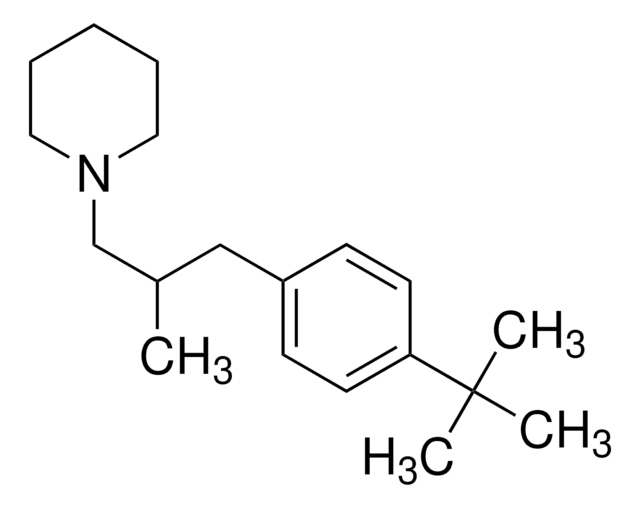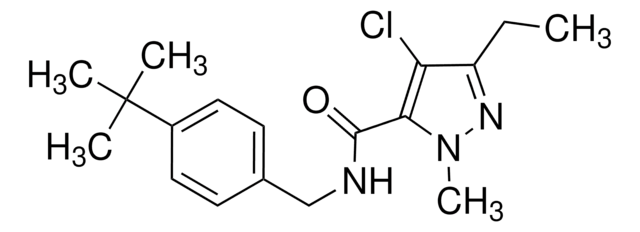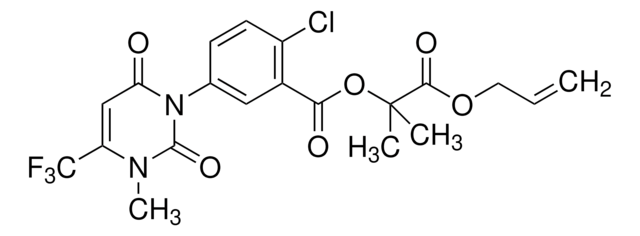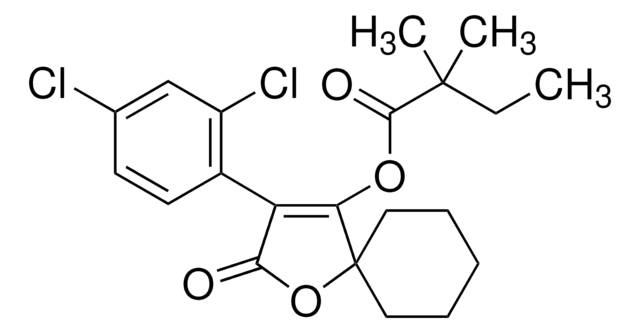Kluczowe dokumenty
CRM52554
Spiroxamine
certified reference material, TraceCERT®, Manufactured by: Sigma-Aldrich Production GmbH, Switzerland
Synonim(y):
N-Ethyl-N-propyl-8-tert-butyl-1,4-dioxaspiro[4.5]dec-2-ylmethylamine
About This Item
Polecane produkty
klasa czystości
certified reference material
TraceCERT®
Poziom jakości
linia produktu
TraceCERT®
okres trwałości
limited shelf life, expiry date on the label
producent / nazwa handlowa
Manufactured by: Sigma-Aldrich Production GmbH, Switzerland
Format
neat
temp. przechowywania
2-8°C
ciąg SMILES
CCCN(CC)CC1COC2(CCC(CC2)C(C)(C)C)O1
InChI
1S/C18H35NO2/c1-6-12-19(7-2)13-16-14-20-18(21-16)10-8-15(9-11-18)17(3,4)5/h15-16H,6-14H2,1-5H3
Klucz InChI
PUYXTUJWRLOUCW-UHFFFAOYSA-N
Szukasz podobnych produktów? Odwiedź Przewodnik dotyczący porównywania produktów
Opis ogólny
Certified content by quantitative NMR incl. uncertainty and expiry date are given on the certificate.
Download your certificate at: http://www.sigma-aldrich.comSpiroxamine is a systemic fungicide that belongs to the class of synthetic amines or morpholines. It targets the ∆14-reductase enzyme and inhibits sterol biosynthesis. It is used against powdery mildew, rust, and spot fungi on cereals and grapes for its protective, curative, and eradicative activities.
As per Regulation (EC) No. 1107/2009, repealing directive 91/414/EEC, spiroxamine is approved for use in the European Union (EU). A maximum residue limit (MRL) of 0.01 mg/kg and 0.05 mg/kg is applicable for the presence of spiroxamine in fresh/frozen fruits and tree nuts respectively, in accordance with Regulation (EC) No. 2016/452. Spiroxamine is to be monitored in the Multiannual Control Programme for Pesticides Residues (MACP), run within the EU and EFTA in/on products of plant origin.
Zastosowanie
The spiroxamine CRM may also find the following uses:
- Development of an enantioselective method to determine three fungicide residues in grapevine, sugar beet, and wheat samples by gas chromatography-tandem mass spectrometry (GC-MS/MS)
- Quantification of 19 neonicotinoids and fungicides from pollen and individual bumblebee samples using modified QuEChERS extraction with ultra-high performance liquid chromatography-tandem mass spectrometry (UHPLC-MS/MS)
- Evaluation of a gas chromatographic method with electron capture and nitrogen phosphorus detection (GC/ECD/NPD) for the analysis of 46 pesticides in fresh peppermint samples
- Multi-residue determination of 25 pesticide residues in red wine by gas chromatography-mass spectrometry(GC-MS)
- QuEChERS extraction and liquid chromatography-tandem mass spectrometry based determination of 42 pesticides in six marijuana samples
- Investigation of three different sample preparation methods to select the most suitable one for the analysis of 98 pesticides in globe artichoke leaves and fruit samples by LC-MS and GC-MS
Informacje prawne
Nie możesz znaleźć właściwego produktu?
Wypróbuj nasz Narzędzie selektora produktów.
Hasło ostrzegawcze
Warning
Zwroty wskazujące rodzaj zagrożenia
Zwroty wskazujące środki ostrożności
Klasyfikacja zagrożeń
Acute Tox. 4 Dermal - Acute Tox. 4 Inhalation - Acute Tox. 4 Oral - Aquatic Acute 1 - Aquatic Chronic 1 - Repr. 2 - Skin Irrit. 2 - Skin Sens. 1 - STOT RE 2
Organy docelowe
Eyes
Kod klasy składowania
10 - Combustible liquids
Klasa zagrożenia wodnego (WGK)
WGK 3
Temperatura zapłonu (°F)
296.6 °F
Temperatura zapłonu (°C)
147 °C
Wybierz jedną z najnowszych wersji:
Certyfikaty analizy (CoA)
Nie widzisz odpowiedniej wersji?
Jeśli potrzebujesz konkretnej wersji, możesz wyszukać konkretny certyfikat według numeru partii lub serii.
Masz już ten produkt?
Dokumenty związane z niedawno zakupionymi produktami zostały zamieszczone w Bibliotece dokumentów.
Nasz zespół naukowców ma doświadczenie we wszystkich obszarach badań, w tym w naukach przyrodniczych, materiałoznawstwie, syntezie chemicznej, chromatografii, analityce i wielu innych dziedzinach.
Skontaktuj się z zespołem ds. pomocy technicznej











